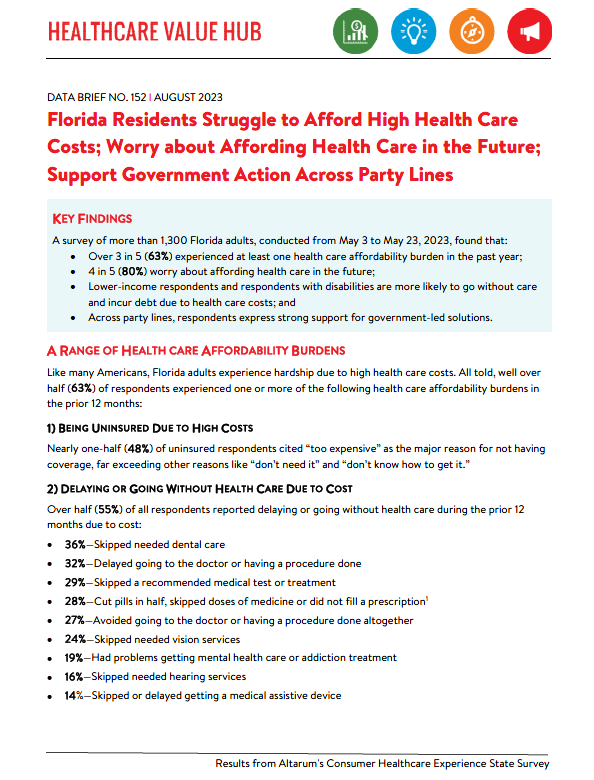Florida Residents Struggle to Afford High Health Care Costs; Worry about Affording Health Care in the Future; Support Government Action Across Party Lines
Key Findings
A survey of more than 1,300 Florida adults, conducted from May 3 to May 23, 2023, found that:
- Over 3 in 5 (63%) experienced at least one health care affordability burden in the past year;
- 4 in 5 (80%) worry about affording health care in the future;
- Lower-income respondents and respondents with disabilities are more likely to go without care and incur debt due to health care costs; and
- Across party lines, respondents express strong support for government-led solutions.
A Range of Healthcare Affordability Burdens
Like many Americans, Florida adults experience hardship due to high health care costs. All told, well over
half (63%) of respondents experienced one or more of the following health care affordability burdens in
the prior 12 months:
1) Being Uninsured Due to High Costs
Nearly one-half (48%) of uninsured respondents cited “too expensive” as the major reason for not having
coverage, far exceeding other reasons like “don’t need it” and “don’t know how to get it.”
2) Delaying or Going Without Healthcare Due to Cost
Over half (55%) of all respondents reported delaying or going without health care during the prior 12
months due to cost:
- 36%—Skipped needed dental care
- 32%—Delayed going to the doctor or having a procedure done
- 29%—Skipped a recommended medical test or treatment
- 28%—Cut pills in half, skipped doses of medicine or did not fill a prescription1
- 27%—Avoided going to the doctor or having a procedure done altogether
- 24%—Skipped needed vision services
- 19%—Had problems getting mental health care or addiction treatment
- 16%—Skipped needed hearing services
- 14%—Skipped or delayed getting a medical assistive device
Moreover, respondents cited cost as the most frequently cited reason for them or a family member not
getting needed medical care in the past year, exceeding a host of other barriers like getting time off work,
transportation, and lack of childcare.
3) Struggling to Pay Medical Bills
Other times, respondents got the care they needed but struggled to pay the resulting bill. Nearly two in
five (39%) experienced one or more of these struggles to pay their medical bills:
- 16%—Used up all or most of their savings
- 15%—Were contacted by a collection agency
- 13%—Were unable to pay for basic necessities like food, heat or housing
- 12%—Racked up large amounts of credit card debt
- 11%—Borrowed money, got a loan or another mortgage on their home
- 7%—Were placed on a long-term payment plan
Of the various types of medical bills, the ones most frequently associated with an affordability barrier
were doctor bills, dental bills, and prescription drugs. The high prevalence of affordability burdens for
these services likely reflects the frequency with which Florida respondents seek these services. Trouble
paying for dental bills likely reflects lower rates of coverage for these services.
High Levels of Worry About Affording Healthcare in the Future
Florida respondents also exhibit high levels of worry about affording health care in the future. Four in five
(80%) reported being “worried” or “very worried” about affording some aspect of health care in the
future, including:
- 63%—Cost of nursing home or home care services
- 62%—Health insurance will become unaffordable
- 62%—Medical costs when elderly
- 60%—Medical costs in the event of a serious illness or accident
- 56%—Cost of dental care
- 53%—Prescription drugs will become unaffordable
- 49%—Cost of needed vision services
- 47%—Cost of needed hearing services
While two of the most common worries—affording the cost of nursing home or home care services and
medical costs when elderly—are applicable predominantly to an older population, they were most
frequently reported by respondents ages 35-54. This finding suggests that Florida respondents may be
worried about affording the cost of care for both aging parents and themselves.
Worry about affording health care was highest among respondents living in lower-income households and
among those living in households with a person with a disability (see Table 1). More than 4 in 5 (86% of)
respondents with household incomes of less than $50,000 per year2 reported worrying about affording
some aspect of coverage or care in the past year. Still, most Florida respondents of all incomes, races,
ethnicities, geographic setting, and levels of ability are somewhat or very concerned.
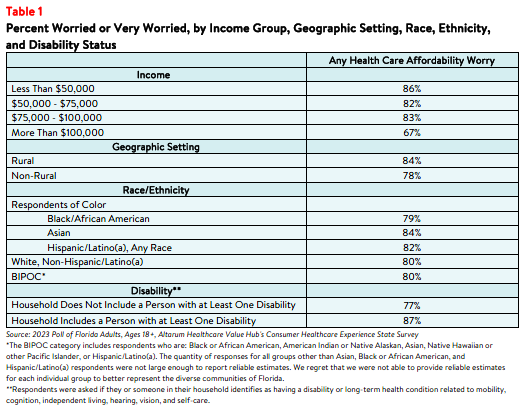
Concern that health insurance will become unaffordable is also more prevalent among certain groups of
Florida respondents. By insurance type, respondents with coverage that they have purchased on their
own, not through an employer, most frequently reported worrying about affording coverage, followed by
respondents with coverage through their employer and those with Medicaid coverage (see Figure 1).
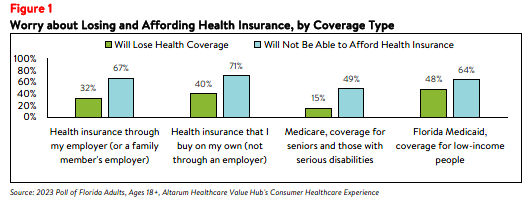
Respondents with household incomes below $50,000 per year reported the highest rates of worry about
losing coverage and affording coverage. Rural respondents and those living in households with a person
with a disability were more likely to be concerned about losing health insurance than respondents living in
non-rural areas and those living in a household without a person with a disability (see Table 2).
Concerns about affording coverage exceeded fears about losing coverage across all income groups,
disability statuses, geographic settings (see Appendix A), races, ethnicities, and coverage types.
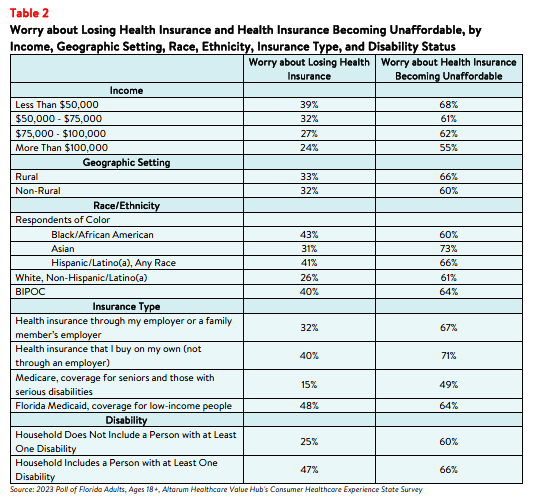
Differences in Healthcare Affordability Burdens
The survey also revealed differences in how Florida respondents experience health care affordability
burdens by income, age, geographic setting, race, ethnicity, and disability status.
Income and Age
Unsurprisingly, respondents at the lowest end of the income spectrum most frequently reported
experiencing one or more health care affordability burdens, with nearly three-fourths (74%) of those
earning less than $50,000 per year reporting struggling to afford some aspect of coverage or care in the
past 12 months (see Figure 2). This may be due, in part, to respondents in this income group reporting higher rates of going without care and rationing their medication due to cost (see Figure 3).
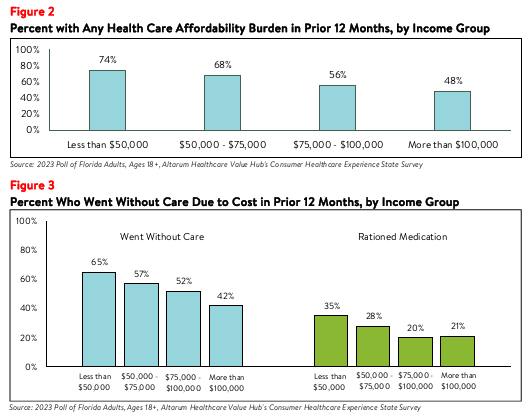
Further analysis found that Florida respondents ages 18-44 were more likely to go without care due to
cost than respondents ages 45 and older (see Figure 4). Respondents ages 18-44 also most frequently
reported rationing medication due to cost, compared to other age groups.
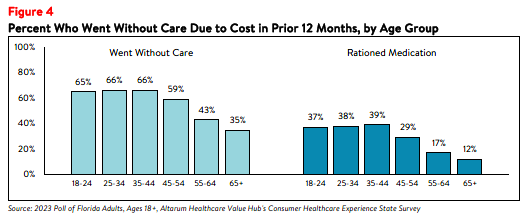
Disability Status
Of all the demographic groups measured, respondents living in households with a person with a disability
reported the highest rates of going without care and rationing medication due to cost in the past 12
months. Over 7 in 10 (74% of) respondents in this group reported going without some form of care and
44% reported rationing medication, compared to 47% and 21% of respondents living in households
without a person with a disability, respectively (see Table 4). Respondents living in households with a
person with a disability also more frequently reported delaying or skipping getting mental health care,
addiction treatment, and dental care, among other health care services, than those in households without
a person with a disability due to cost concerns (see Table 3).
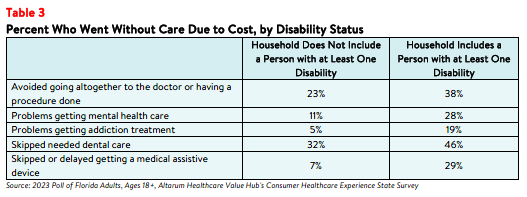
Those with disabilities also face health care affordability burdens unique to their disabilities—29% of
respondents reporting a disability in their household reported delaying getting a medical assistive device
such as a wheelchair, cane/walker, hearing aid, or prosthetic limb due to cost. Just 7% of respondents
without a person with a disability (who may have needed such tools temporarily or may not identify as
having a disability) reported having this experience.
Insurance Type
Respondents with Florida Medicaid coverage reported the highest rates of going without care due to cost
and rationing medication, followed by respondents with private insurance (see Table 4). Still, over two-
fifths of respondents with Medicare coverage went without care due to cost in the twelve months prior to
taking the survey.
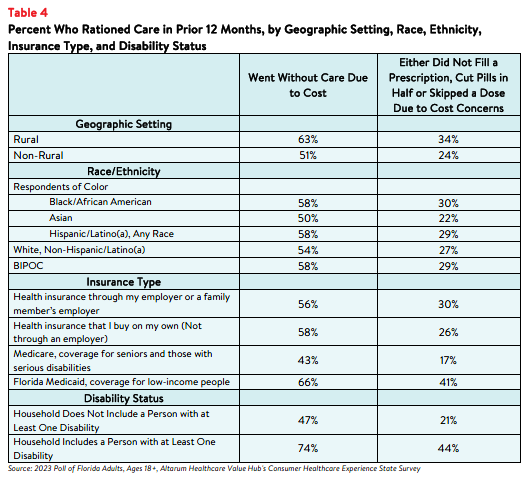
Survey respondents also had the opportunity to share their own stories about going without care due to
cost in the past year. Notably, respondents with both private insurance and Medicaid coverage reported
challenges affording care (see Table 5).
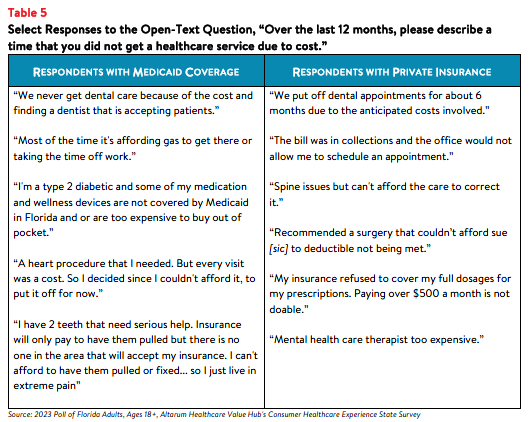
Race and Ethnicity
Florida respondents of color reported higher rates of rationing medication and forgoing care than white
respondents. Fifty-eight percent of Black respondents and 58% of Hispanic/Latino(a) respondents
reported going without care due to cost in the past twelve months (see Table 4). Further analysis showed
that respondents of color also reported higher rates of challenges receiving mental health care and
skipping needed dental care (see Figure 5).
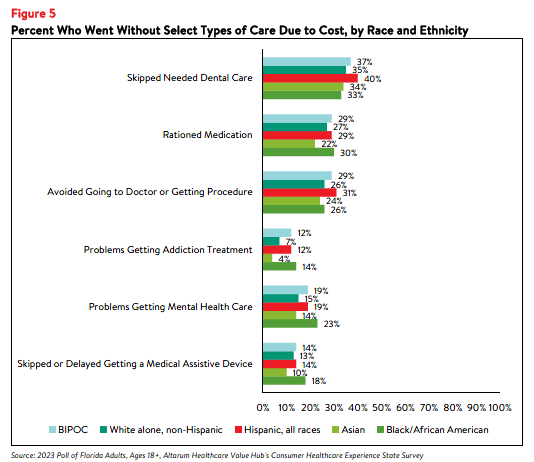
Encountering Medical Debt
The survey also showed differences in the prevalence of financial burdens due to medical bills, including
going into medical debt, depleting savings, and being unable to pay for basic necessities (like food, heat,
and housing) by income, race, ethnicity, disability status, and geographic setting. Fifty-two percent of
Black respondents and 49% of Hispanic/Latino(a) respondents reported going into debt, depleting
savings, or going without other needs due to medical bills, compared to 33% of white alone, non-Hispanic
respondents (see Table 6).
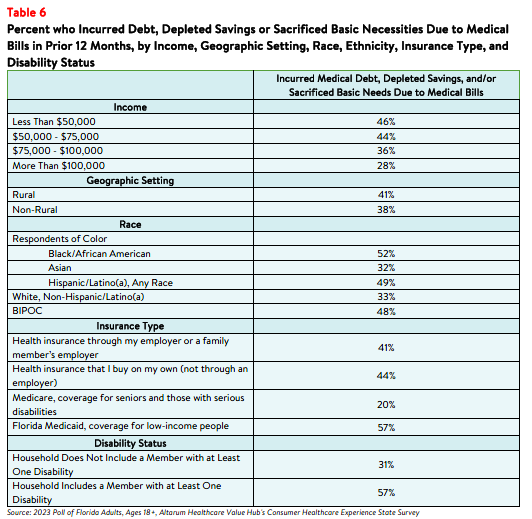
The rate of financial burden is even higher for respondents who have or live with a person with a disability,
with nearly three-fifths (57%) reporting going into debt or going without other needs due to medical bills,
compared to 31% of respondents living in households without a disabled member. Geographically, rural
residents across Florida reported higher rates of going into debt or going without other needs due to
medical bills. In addition, respondents with Medicaid coverage reported the highest rate of the above
financial burdens due to medical bills (57%), compared to respondents with all other insurance types.
Impact of Hospital Consolidation
In addition to the above health care affordability burdens, 9% of respondents reported that they or
someone in their household were unable to access their preferred health care organization because of a
merger that made their preferred organization out-of-network. When asked about the greatest burden
hospital mergers had created for respondents and their families, the top three most frequently reported
issues were:
- 34%—Additional financial burden
- 26%—Added wait time when searching for a new provider accepting patients
- 21%—Gap in my continuity of care (my former provider knew me and now I have to explain everything again)
Dissatisfaction with the Health System and Support for Change
In light of Florida respondents’ health care affordability burdens and concerns, it is not surprising that
they are dissatisfied with the health system:
- Just 30% agreed or strongly agreed that “we have a great healthcare system in the U.S.,”
- While 68% agreed or strongly agreed that “the system needs to change."
To investigate further, the survey asked about both personal and governmental actions to address health
system problems.
Personal Actions
Florida respondents see a role for themselves in addressing health care affordability. When asked about
specific actions they could take:
- 55% of respondents reported researching the cost of a drug beforehand, and
- 73% said they would be willing to switch from a brand name to an equivalent generic drug if given the chance.
When asked to select the top three personal actions they felt would be most effective in
addressing health care affordability (out of ten options), the most common responses were:
- 74%—Take better care of my personal health
- 45%—Research treatments myself, before going to the doctor
- 33%—Do more to compare doctors on cost and quality before getting services
- 25%—There is not anything I can do personally to make our health system better
Government Actions
But far and away, Florida respondents see government as the key stakeholder that needs to act to address health system problems. Moreover, addressing health care problems is one of the top priorities that respondents want their elected officials to work on.
At the beginning of the survey, respondents were asked what issues the government should address in the upcoming year. The top vote getters were:
- 50%—Economy/Joblessness
- 47%—Health care
- 35%—Affordable Housing
When asked about the top three health care priorities the government should work on, the top vote getters were:
- 49%—Address high health care costs, including prescription drugs
- 34%—Preserve consumer protections preventing people from being denied coverage or charged more for having a pre-existing medical condition
- 32%—Get health insurance to those who cannot afford coverage
- 30%—Improve Medicare, coverage for seniors and those with serious disabilities
Of more than 20 options, Florida respondents believe the reason for high health care costs is unfair prices
charged by powerful industry stakeholders:
- 72%—Drug companies charging too much money
- 69%—Hospitals charging too much money
- 66%—Insurance companies charging too much money
When it comes to tackling costs, respondents endorsed a number of strategies, including:
- 91%—Require insurers to provide up-front cost estimates to consumers
- 91%—Show what a fair price would be for specific procedures
- 90%—Set standard prices for drugs to make them affordable
- 90%—Cap out-of-pocket costs for life-saving medications, such as insulin
- 90%—Require drug companies to provide advanced notice of prices increases and information to justify those increases
- 89%—Require hospitals and doctors to provide up-front cost estimates to consumers
- 89%—Make it easy to switch insurers if a health plan drops your doctor
- 89%—Authorize the Attorney General to take legal action to prevent price gouging or unfair prescription price hikes
- 88%—Expand health insurance options so that everyone can afford quality coverage
Support for Action Across Party and Racial/Ethnic Lines
There is also remarkable support for change regardless of respondents' political affiliation (see Table 7).
The high burden of health care affordability, along with high levels of support for change, suggest that
elected leaders and other stakeholders need to make addressing this consumer burden a top priority.
Moreover, the COVID crisis has led state residents to take a hard look at how well health and public health systems are working for them, with strong support for a wide variety of actions. Annual surveys can help assess whether progress is being made.
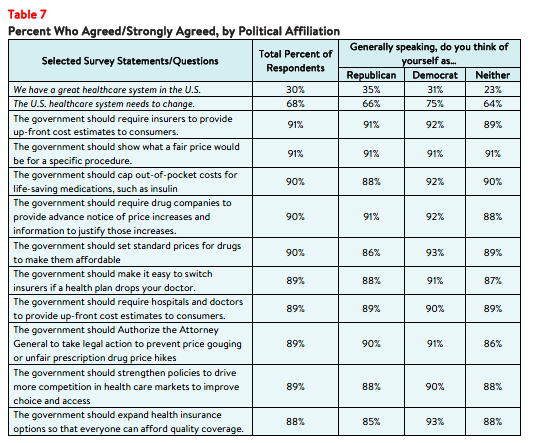
Notes
- Of the current 55% of Florida respondents who encountered one or more cost-related barriers to getting health care during the prior 12 months, 22% did not fill a prescription, while 19% cut pills in half or skipped doses of medicine due to cost.
- Median household income in Florida was $61,777 (2017-2021). U.S. Census, Quick Facts. Retrieved from: U.S. Census Bureau QuickFacts: Florida
Methodology
Altarum’s Consumer Healthcare Experience State Survey (CHESS) is designed to elicit respondents’ unbiased views on a wide range of health system issues, including confidence using the health system, financial burden and possible policy solutions.
This survey, conducted from May 3 to May 23, 2023, used a web panel from online survey company Dynata with a demographically balanced sample of approximately 1,514 respondents who live in Florida. Information about Dynata’s recruitment and compensation methods can be found here. The survey was conducted in English or Spanish and restricted to adults ages 18 and older. Respondents who finished the survey in less than half the median time were excluded from the final sample, leaving 1,376 cases for analysis. After those exclusions, the demographic composition of respondents was as follows, although not all demographic information has complete response rates:
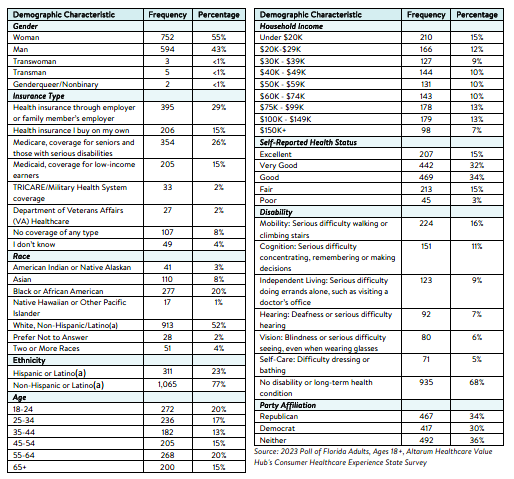
Percentages in the body of the brief are based on weighted values, while the data presented in the demographic table is unweighted. An explanation of weighted versus unweighted variables is available here.
Altarum does not conduct statistical calculations on the significance of differences between groups in findings. Therefore, determinations that one group experienced a significantly different affordability burden than another should not be inferred. Rather, comparisons are for conversational purposes. The groups selected for this brief were selected by advocate partners in each state based on organizational/advocacy priorities. We do not report any estimates under N=100 and a co-efficient of variance more than 0.30.
Appendix A
The state was divided into rural and non-rural regions, by county.
|
Rural |
Non-Rural |
|
Baker County, Florida |
Alachua County, Florida |
|
Bradford County, Florida |
Bay County, Florida |
|
Calhoun County, Florida |
Brevard County, Florida |
|
Columbia County, Florida |
Broward County, Florida |
|
DeSoto County, Florida |
Charlotte County, Florida |
|
Dixie County, Florida |
Citrus County, Florida |
|
Franklin County, Florida |
Clay County, Florida |
|
Gadsden County, Florida |
Collier County, Florida |
|
Gilchrist County, Florida |
Duval County, Florida |
|
Glades County, Florida |
Escambia County, Florida |
|
Gulf County, Florida |
Flagler County, Florida |
|
Hamilton County, Florida |
Hernando County, Florida |
|
Hardee County, Florida |
Hillsborough County, Florida |
|
Hendry County, Florida |
Indian River County, Florida |
|
Highlands County, Florida |
Lake County, Florida |
|
Holmes County, Florida |
Lee County, Florida |
|
Jackson County, Florida |
Leon County, Florida |
|
Jefferson County, Florida |
Manatee County, Florida |
|
Lafayette County, Florida |
Marion County, Florida |
|
Levy County, Florida |
Martin County, Florida |
|
Liberty County, Florida |
Miami-Dade County, Florida |
|
Madison County, Florida |
Okaloosa County, Florida |
|
Monroe County, Florida |
Orange County, Florida |
|
Nassau County, Florida |
Osceola County, Florida |
|
Okeechobee County, Florida |
Palm Beach County, Florida |
|
Putnam County, Florida |
Pasco County, Florida |
|
Sumter County, Florida |
Pinellas County, Florida |
|
Suwannee County, Florida |
Polk County, Florida |
|
Taylor County, Florida |
Santa Rosa County, Florida |
|
Union County, Florida |
Sarasota County, Florida |
|
Wakulla County, Florida |
Seminole County, Florida |
|
Walton County, Florida |
St. Johns County, Florida |
|
Washington County, Florida |
St. Lucie County, Florida |
|
|
Volusia County, Florida |


